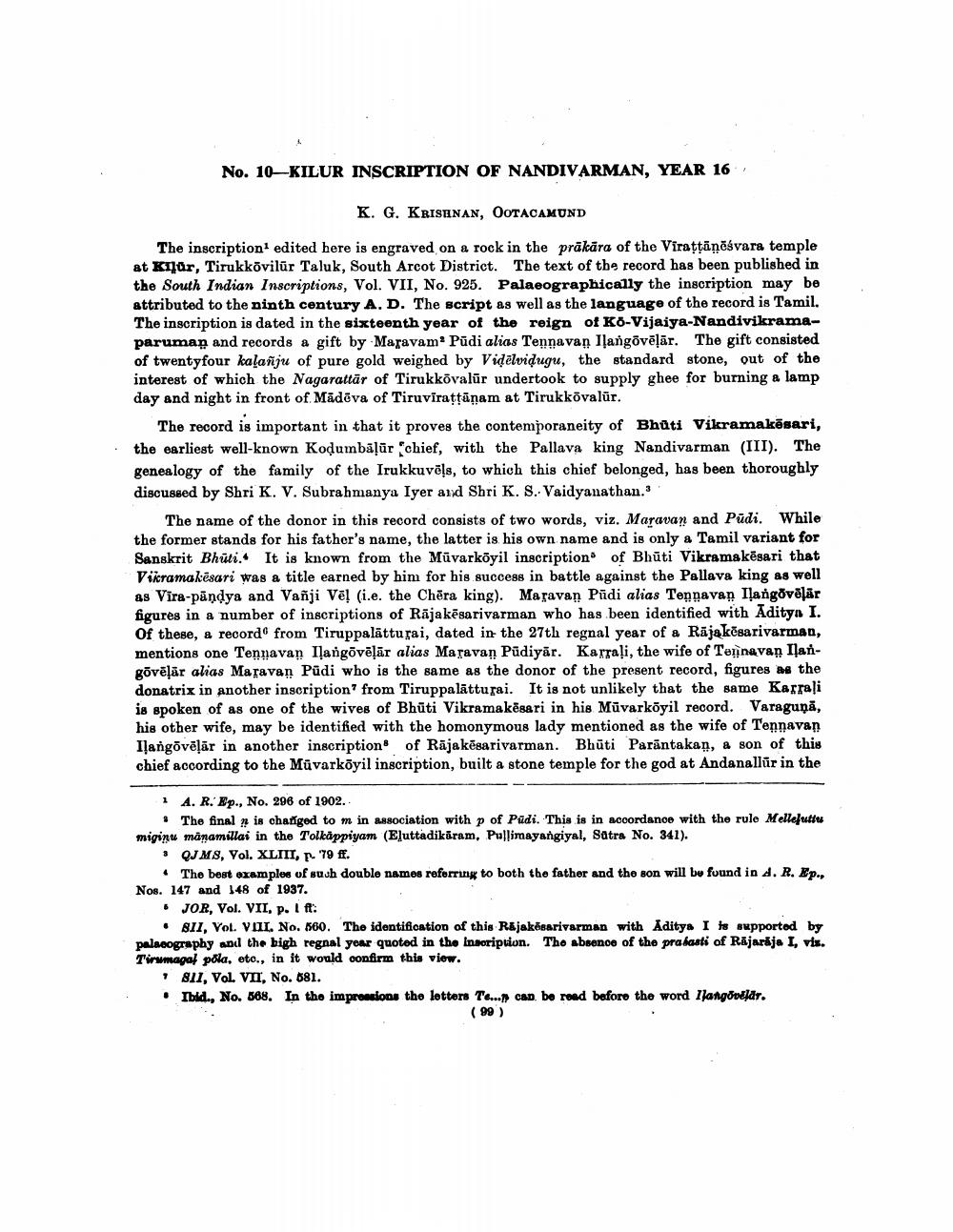________________
No. 10 KILUR INSCRIPTION OF NANDIVARMAN, YEAR 167
K. G. KRISHNAN, OOTACAMUND
The inscription1 edited here is engraved on a rock in the prākāra of the Viraṭṭāņēśvara temple at Kür, Tirukkövilür Taluk, South Arcot District. The text of the record has been published in the South Indian Inscriptions, Vol. VII, No. 925. Palaeographically the inscription may be attributed to the ninth century A. D. The script as well as the language of the record is Tamil. The inscription is dated in the sixteenth year of the reign of Ko-Vijaiya-Nandivikramaparuman and records a gift by Maravam Pudi alias Tennavan Ilangōvēlār. The gift consisted of twentyfour kalañju of pure gold weighed by Videlviḍugu, the standard stone, out of the interest of which the Nagarattar of Tirukkōvalur undertook to supply ghee for burning a lamp day and night in front of Madeva of Tiruviraṭṭāņam at Tirukkōvalür.
The record is important in that it proves the contemporaneity of Bhuti Vikramakēsari, the earliest well-known Koḍumbāļūr chief, with the Pallava king Nandivarman (III). The genealogy of the family of the Irukkuvels, to which this chief belonged, has been thoroughly discussed by Shri K. V. Subrahmanya Iyer and Shri K. S. Vaidyanathan.3
The name of the donor in this record consists of two words, viz. Maravan and Pūdi. While the former stands for his father's name, the latter is his own name and is only a Tamil variant for Sanskrit Bhuti. It is known from the Müvarkōyil inscription of Bhūti Vikramakēsari that Vikramakesari was a title earned by him for his success in battle against the Pallava king as well as Vira-pandya and Vañji Vēl (i.e. the Chera king). Maravan Pidi alias Tennavan Ilangōvēlār figures in a number of inscriptions of Rajakesarivarman who has been identified with Aditya I. Of these, a record from Tiruppalatturai, dated in the 27th regnal year of a Rajakēsarivarman, mentions one Tennavan Пlangōvēļār alias Maravan Pūdiyar. Karrali, the wife of Tennavan Ilangōvēļār alias Maravan Pudi who is the same as the donor of the present record, figures as the donatrix in another inscription" from Tiruppalatturai. It is not unlikely that the same Karrali is spoken of as one of the wives of Bhuti Vikramakesari in his Mūvarkōyil record. Varaguņā, his other wife, may be identified with the homonymous lady mentioned as the wife of Tennavan Ilangōvēļār in another inscription of Rajakesarivarman. Bhuti Parantakan, a son of this chief according to the Müvarkōyil inscription, built a stone temple for the god at Andanallur in the
1 A. R. Ep., No. 296 of 1902.
The final is changed to m in association with p of Pudi. This is in accordance with the rule Mellefuttes miginu manamillai in the Tolkäppiyam (Eluttadikäram, Pullimayangiyal, Satra No. 341).
3 QJMS, Vol. XLIII, p. 79 ff.
The best examples of such double names referring to both the father and the son will be found in A. R. Ep., Nos. 147 and 148 of 1937.
JOR, Vol. VII, p. 1 ft:
⚫ 811, Vol. VIII. No. 560. The identification of this Rajakesarivarman with Aditya I is supported by palaeography and the bigh regnal year quoted in the inscription. The absence of the prasasti of Rajarāja I, viz. Tirumagal pola, etc., in it would confirm this view.
811, Vol. VII, No. 581.
⚫ Ibid., No. 568. In the impressions the letters Te... can be read before the word llangóvēlär. (99)




